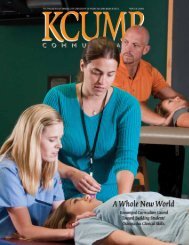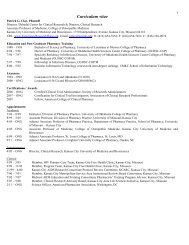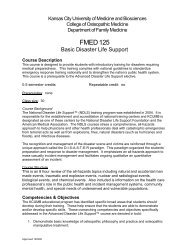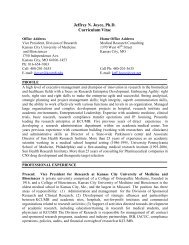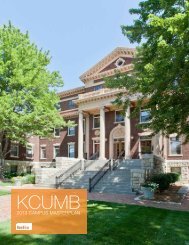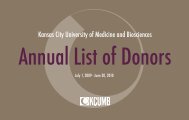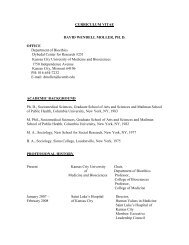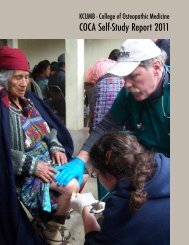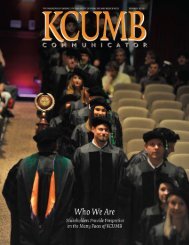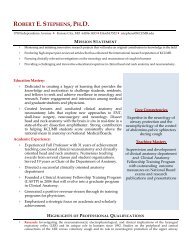KCUMBmagazine - Kansas City University of Medicine and ...
KCUMBmagazine - Kansas City University of Medicine and ...
KCUMBmagazine - Kansas City University of Medicine and ...
Create successful ePaper yourself
Turn your PDF publications into a flip-book with our unique Google optimized e-Paper software.
“I wasn’t going to take ‘no’ for an answer.That’s my modus oper<strong>and</strong>i.”Dr. Gordonto date, there have been at least 15 ‘saves’ as a result<strong>of</strong> this initiative,” said Sue Hobson, director <strong>of</strong> communityhealth <strong>and</strong> community relations at Akron General MedicalCenter. In 2002, Hobson served as the statewide initiative’sproject manager, so she came to know that Dr. Gordon’simpact on the issue was critically important.it’s really been Terry’s perseverance <strong>and</strong> diligence thatmade this happen,” she said. “Before, I had known him asone <strong>of</strong> the hospital’s excellent cardiologists, but he’s also agem <strong>of</strong> a man. Very, very giving <strong>and</strong> supportive.”For his efforts, Dr. Gordon was named as the 2002 NationalPhysician <strong>of</strong> the Year by the American Heart Association.The same day the Ohio initiative was completed,U.S. Rep. Betty Sutton (Ohio) asked Dr. Gordon abouttaking the integrated program to the national stage. In2008, Rep. Sutton introduced The Josh Miller HEARTSAct (HR 4926) in the U.S. House <strong>of</strong> Representatives. TheHouse passed it later that year, sending it to the U.S. Senate.The bill, however, failed to make it out <strong>of</strong> committee,despite endorsements from the AHA, the American RedCross, the National Education Association, the AmericanAcademy <strong>of</strong> Pediatricians <strong>and</strong> the National Safety Council,among others.“I wasn’t going to take no for an answer,” Dr. Gordonsaid. “That’s my modus oper<strong>and</strong>i.”new versions <strong>of</strong> the House bill were introduced in2009 <strong>and</strong> 2011. A Senate version <strong>of</strong> the legislation was introducedin February 2012. The legislation has yet to makeit out <strong>of</strong> the Senate Health, Education, Labor <strong>and</strong> PensionsCommittee.Meanwhile, statistics show that since the bill was firstintroduced, “206 children have needlessly died <strong>of</strong> cardiacarrest in our nation’s schools,” according to an article publishedby Parent Heart Watch, a national AED advocacyorganization.Dr. Gordon’s large-scale efforts to increase the use<strong>and</strong> distribution <strong>of</strong> automated external defibrillators are aproduct <strong>of</strong> his belief that he is here to help others. Afterall, his destiny to become a physician was revealed clearlyto him at just 7 years old. Growing up in Louisville, Ky.,Dr. Gordon recalls seeing a late 1950s TV program called“Operation Open Heart,” which showed actual footage <strong>of</strong>open-heart surgeries.“I remember a patient named Gussie, unable to doanything (before surgery),” Dr. Gordon said. “Then, theyshowed Gussie afterward. (That’s when) I decided to be adoctor.”The path to Dr. Gordon’s ultimate goal <strong>of</strong> becoming aphysician was not easy, though. He found himself on a jaggedjourney, driven by a dream that he would not – couldnot – let go. He tells the story <strong>of</strong> his father becoming illduring his freshman year at Emory <strong>University</strong>. The emotionalturmoil resulted in him receiving a “D” in chemistry. That’s adisturbing start for anyone hoping to enter medical school.Dr. Gordon settled for a bachelor’s degree in psychologyat Emory. Still holding on to the idea <strong>of</strong> a medical career,he decided to look at Tulane <strong>University</strong>, intending toget a master’s degree in hospital administration. Yet, in anotherdefining moment, Dr. Gordon recalls walking witha pr<strong>of</strong>essor in Tulane’s hospital administration programduring his visit to campus. As they walked between hospitalbuildings they were about to tour, the pr<strong>of</strong>essor lookedup <strong>and</strong> wistfully noted that “sometimes I forget there arepatients in there.”not see patients? Not have the ability to help <strong>and</strong> healon a personal level? Unacceptable, thought Dr. Gordon. Heknew he needed to be in medical school.As destiny might have it, Dr. Gordon’s brother-in-law,Barry Siegel, D.O. (COM ’71), was a KCUMB graduate <strong>and</strong>practicing family medicine in Coral Gables, Fla. Ensuingconversations about the <strong>University</strong> <strong>and</strong> its approach to osteopathicmedical education led Dr. Gordon to apply <strong>and</strong>be accepted at the <strong>University</strong> in 1976.“It’s been a perfect fit,” Dr. Gordon said. “The holisticapproach to medicine had always attracted me. I knewthat somehow everything is connected. Each system is ina symbiotic relationship with the others. Every cell in thebody is there for the good <strong>of</strong> the whole.”Dr. Gordon gives a brief explanation<strong>of</strong> how the automatedexternal defibrillator works toa school <strong>of</strong>ficial while st<strong>and</strong>ingon the sideline at a footballpractice. He has been instrumentalin getting AEDs in allOhio middle <strong>and</strong> high schools.He remembers his years at KCUMB quite fondly <strong>and</strong>vividly, noting that the more education he went through,the more empowered he felt.“The education I received there was superb,” Dr. Gordonsaid.After receiving his medical degree, Dr. Gordon did anemergency medicine rotation at Akron General, then wasaccepted into the internal medicine program there from1981-84. He also completed a fellowship in invasive cardiologyat the Clevel<strong>and</strong> Clinic Foundation in 1987.in his 20-plus years <strong>of</strong> service at Akron General, Dr.Gordon achieved board certifications in internal medicine<strong>and</strong> in cardiovascular disease. Dr. Gordon is also wellknown for other community endeavors, including servingas a founding member <strong>of</strong> Stewart’s Caring Place, a facilityfor those with cancer, as well activities with The Youth MotivationalTask Force, which encourages Akron’s inner-cityyouth. He serves as co-host <strong>of</strong> “Docs Who Rock,” an annualAkron United Way fund-raising event.in one sense, Ken Miller is just another admirer <strong>of</strong> Dr.Gordon’s community efforts. Yet, the connection the salesrepresentative feels to Dr. Gordon goes much deeper. Itstarted years ago, that night on a high school football fieldin Summit County. Ken <strong>and</strong> Jerri Miller are the parents <strong>of</strong>Josh Miller, the boy whose tragic death started Dr. Gordon’sefforts to get AEDs in schools.in the years since Josh’s death, the relationship betweenDr. Gordon <strong>and</strong> the Millers has grown increasingly close.continued on page 2018 WINTER 2012 WINTER 2012 19




